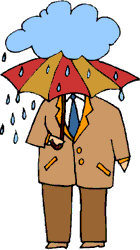Hands-on Activities: Watching the Weather
Grade Level K-4
Essential Question Does the weather stay the same all year long?
Objective The purpose of this activity is to make students more aware of weather changes.
Materials notebook, pencil, graph paper
Approach
 Help your students create a class weather journal. Each day record the weather. The class may do this as a group, or you can assign the tasks to individual students. Students should answer the following questions when they record the weather: Is it raining or snowing? If yes, then how much rain or snow is there? Is it hot or cold? What is the temperature? Is it windy? Is it calm? Is it dark? Is it sunny? If you cannot measure these things, then just describe the weather. For example "very cloudy, cold, very windy, and drizzle." Older students (grades 2-4) can write short sentences to describe the weather. Younger students (grades K-1) can draw pictures of the weather. Help your students create a class weather journal. Each day record the weather. The class may do this as a group, or you can assign the tasks to individual students. Students should answer the following questions when they record the weather: Is it raining or snowing? If yes, then how much rain or snow is there? Is it hot or cold? What is the temperature? Is it windy? Is it calm? Is it dark? Is it sunny? If you cannot measure these things, then just describe the weather. For example "very cloudy, cold, very windy, and drizzle." Older students (grades 2-4) can write short sentences to describe the weather. Younger students (grades K-1) can draw pictures of the weather.
At the end of each month, look at changes in the weather during that month. Students can create graphs displaying changes in weather and store these with the journal entries.
Reflection: At the end of the year, students should examine all of the monthly weather graphs they have created. Ask them to point out when they thought seasonal weather changes were occurring. They should explain their answers using their graphs as support.
Content for this activity provided by Barbara Adkins. Illustration © 2000-2003 www.clipart.com. |











